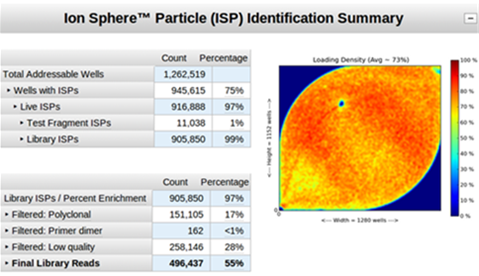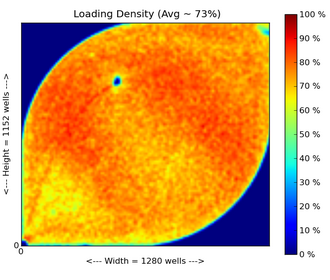Torrent Browser Analysis Report Guide
Classic Ion Sphere Particle (ISP) Summary
This page describes the old style run reports used before release 3.0. The old style run reports use an older layout and do not offer 4.x features. The Classic run report is viewed with the Classic Report button (near the top right of a run report page):

The Ion Sphere Particle (ISP) Identification Summary section of the Analysis Report gives summary statistics of Ion Sphere Particle performance:

This section of the report is available before the
Library Summary
or
Test Fragment Summary
sections, providing a quick determination of whether or not the analysis should be permitted to continue.
The report displays:
Well Information

|
Parameter |
Description |
Percentage |
|---|---|---|
|
Total Addressable Wells |
Total number of addressable wells. |
Not calculated |
|
Wells with ISPs |
Number (and percentage of addressable wells) of wells that were determined to be "positive" for the presence of an ISP within the well. "Positive"is determined by measuring the diffusion rate of a flow with a different pH. Wells containing ISPs have a delayed pH change due to the presence of an ISP slowing the detection of the pH change from the solution. |
Wells with ISPs / Total Addressable Wells |
|
Live ISPs |
Number (and percentage of wells with ISPs) of wells that contained an ISP with a signal of sufficient strength and composition to be associated with the library or Test Fragment key. This value is the sum of the following categories:
|
Live ISPs / Wells with ISPs |
|
Test Fragment ISPs |
Number (and percentage of Live ISPs) of LiveISPs with a key signal that was identical to the Test Fragment key signal. |
Test Fragment ISPs / Live ISPs |
|
Library ISPs |
Number (and percentage of Live ISPs) of Live ISPsthat have a key signal identical to the library key signal. These reads are input into the Library filtering process. |
Library ISPs / Live ISPs |
Library ISP Details
The Library ISP Details table is available after basecalling and read filtering are complete.This tableprovides information on a collection of read filters, which are applied after basecalling to ensure only high-quality reads are written to the final results.
The Polyclonal filter removes ISPs carrying clones from two or more templates.
The Primer dimer filter removes reads carrying an insert of fewer than 8 bp.
The Low quality filter removes reads that fail to attain a high level of accuracy.

|
Parameter |
Description |
Percentage |
|---|---|---|
|
Library ISPs/Percent Enrichment |
Predicted number of Live ISPs that have a key signal identical to the library key signal (the same value as shown in the Well Information table).
|
Library ISPs / (No. of Loaded ISPs minus TF ISPs) |
|
Filtered: Polyclonal |
ISPs carrying clones from two or more templates. |
Polyclonal ISPs / Library ISPs |
|
Filtered: Primer dimer |
Insert length of less than 8 bp. |
Primer dimer ISPs / Library ISPs |
|
Filtered: Low quality |
Low or unrecognizable signal. |
Low quality ISPs / Library ISPs |
|
Final Library Reads |
Number (and percentage of Library ISPs) of reads passing all filters, which are recorded in the unmapped BAM file.
|
Final Library / Library ISPs |
Chip Loading Image
The
Ion Sphere Particle Identification Summary
section includes a Chip Loading Image, similar to the image shown in the following figure:

This is a pseudo-color image of the Ion CHIP wells showing percent loading across the physical surface.
The
Loading Density
percentage is displayed above the image, with the percentage value that considers onlypotentially addressable wells.


